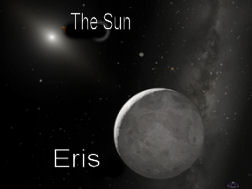A discordant name for a dwarf planet
The largest known object at the fringes of the solar system, the icy body whose discovery heated up the debate about planethood, has an apt new name.

The International Astronomical Union (IAU) announced on Sept. 14 that the body, which had provisionally been called UB 313 and nicknamed Xena, would now be officially called Eris, after the Greek goddess of discord and strife. Furthermore, Eris’ moon has been designated Dysnomia, the goddess of lawlessness.
Because Pluto is slightly smaller than Eris, the discovery of the body in 2005 intensified the controversy about whether Pluto should continue to be called a planet. The IAU voted on Aug. 24 to demote Pluto to “dwarf planet,” a classification that the group devised to separate these objects from planets. Three other objects—Eris, Pluto’s moon Charon, and Ceres, the largest asteroid—are also categorized as dwarf planets (SN: 9/2/06, p. 149: Doggone! Pluto gets a planetary demotion).
Monikers invoking strife and lawlessness are perfect for the newly named dwarf planet and its moon, says Mike Brown of the California Institute of Technology in Pasadena. He and his colleagues, who suggested the names, discovered both objects.
Indeed, the strife is far from over. In late August, a group of more than 300 planetary scientists signed a petition protesting Pluto’s demotion.







